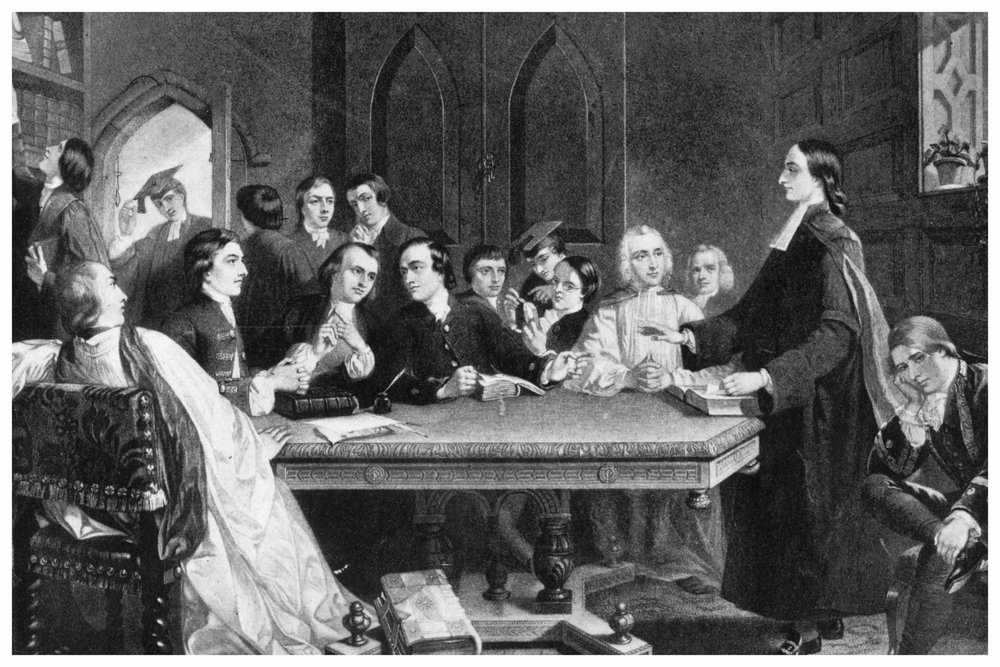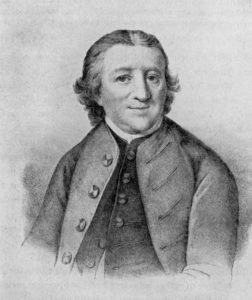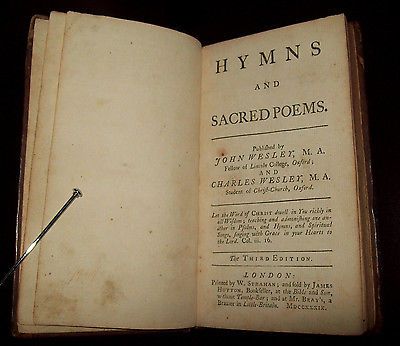Charles was the other Wesley. Alongside his brother John who was considered the main guy behind the founding of Methodism, it was Charles’ hymns that pushed through the envelope of being “just another religion.” His lasting and well-known hymns have captivated Christians all around the world. Through his poetic lines, we are able to sing many hymns with such deep theology.

It was said that he wrote 8,989 hymns. That’s 10 lines of poetry every single day for 50 years. And we are privileged to have sung some of those hymns. Tell me, don’t these hymns ring a bell for you?
“Hark! The Herald Angels Sing”
“And Can It Be”
“O for a Thousand Tongues to Sing”
“Love Divine, All Loves Excelling”
“Christ the Lord Is Risen Today”
“Rejoice! the Lord Is King!”
Beginnings
Charles Wesley (1707-1788) had a rough start. He was the 18th of Samuel and Susanna Wesley’s nineteen children. He was born prematurely and appeared dead during the first few weeks of his life. At fifteen months, he actually almost died. The church where his parents attended caught fire and could’ve burned him to death had it not been for a maid who rescued him.
When old enough, his homeschooling included six hours of Greek, Latin, and French every day, all taught superbly by his mother. His formal education would also include 13 years of studies at Westminster School where he was an eminent scholar and 9 more years at Oxford University where he acquired his master’s degree.
Recognizing the lukewarm spirituality he and many of his friends were in, he and his brother formed a group coined by many as the “Holy Club.” The group was known mostly for their very strict regimen of spiritual study. This included early rising, Bible study, and prison ministry. There was a distinct methodical approach to how they did it, hence they were called a name that stuck until today, “Methodists.”

The Moravian Connection

In 1735, at age 28, Charles was aboard the ship to America. He and his brother were sent to Georgia to be missionaries after being ordained to the ministry. As violent storms threatened their journey, the Wesleys noticed a group of Germans who manifested a certain calmness. This group, who turned out to be Moravians, made a deep, significant and crucial effect on the spirituality of the two brothers.
Attracted by their simple deportment, the Wesleys continued to learn more about the teachings of the Moravians while working in Savannah. On their way back from America, they sought to befriend Count Nikolaus von Zinzendorf, the group’s deeply influential leader, as well as the young Peter Böhler.
Through the help of the Moravians, the Wesleys began to have a clearer understanding of the Bible.They learned that they could not depend on their own works for salvation and must trust wholly in Christ.
Back in London, John attended a Moravian meeting where a passage from Martin Luther’s writing was read. It described the change which the believer goes through as a result of the Holy Spirit. John later wrote, “I felt my heart strangely warmed. I felt I did trust in Christ, Christ alone, for salvation: and an assurance was given me, that He had taken away my sins, even mine, and saved me from the law of sin and death.”
Charles was also gaining a personal conviction. Three days before John attended the meeting, he wrote in his journal, “I now found myself at peace with God and rejoiced in hope of loving Christ…”
Understanding God’s free grace gave more life to the Wesleys’ strict and self-denying behavior. They continued their methodical worship and study, not as a ground, but rather as a result of their faith. “…not the root, but the fruit of holiness,” as Ellen White described it.
Related Post: The Moravians — Their Beginnings, Music and Mission
A passion for ministry
This new-found faith had an impact on Charles’ ministry. In his journal entries, he reported preaching to crowds of ten thousand from June 24-July 1738. He preached to 20,000 more at his alma mater. From 1739 to 1743, he faithfully computed that within five years, a total of 149,400 has heard him preach.
On a trip to Wales in 1747, the 40-year-old evangelist met 20-year-old Sally Gwynne, whom he soon married. By all accounts, their marriage was a happy one.
His last nationwide trip was in 1756. After that, his health led him gradually to withdraw from itinerant ministry. He spent the remainder of his life in Bristol and London, preaching at Methodist chapels.
His Nature and Character

We may have caught a glimpse of his influence as an evangelist, but what do people say about his nature and character?
John Hampson, the earliest Methodist biographer, described him as a gentleman “of a warm and lively disposition, of great frankness and integrity…” Hampson went on to say that Charles was a people person, and respected all men, but would not tolerate hypocrisy. People enjoyed conversing with him, and found him “pleasing and instructive and often seasoned with wit and humour.” He did not hide his religion, but people don’t get rubbed in the face with it either. To them, “his religion was of the right sort: not gloomy and cynical, but cheerful and benevolent.”
In comparison to John, Charles was more stocky and stout. There were periods in his life when he felt sick after eating, so he resorted to a vegetarian diet. He preferred privacy than being under the public eye. He was an affectionate father who was always concerned for the temporal and spiritual welfare of his children. He had a happy and satisfying marriage.
His friends thought about him as “open, courageous, impetuous, large-hearted and a good if sometimes wary judge of character.” In one of John’s letters to him, he described Charles as the heart, while he, John, was the head. Charles was mostly known to use his intuition and emotion rather than the logic and far-sighted strategies of his brother.
The Hymns of Charles Wesley

I will not be writing this article at all if it wasn’t for his hymns. It is important to note that the understanding of justification by faith was a paradigm shift for Charles Wesley. This manifested itself tangibly through his hymns.
A historian wrote, “this experience [pertaining to understanding justification by faith] released a flowing spring of hymn writing, an exuberant, biblical and highly-crafted expression of Christian teaching, discipleship, emotion, and response, unparalleled and apparently timeless in its appeal.”
His brother described his hymns to be “distinct and full account of scriptural Christianity.” Another historian commented that his hymns are like “an enormous sponge, filled to saturation with Bible words, Bible similes, Bible metaphors, Bible stories, Bible ideas.”
Hundreds of years later, a famous clergyman and abolitionist would boldly declare,
'I would rather have written that hymn of Wesley's, 'Jesus, Lover of My Soul,' than to have the fame of all the kings that ever sat on the earth.' -Henry Ward BeecherClick To TweetHymnographers, poets and scholars have analyzed the power and vitality of his writings and would declare it to be “fervid, lucid, forceful and direct.”
Obviously, Charles had a superb craftsmanship in verse, but it is not because of his skill that we sing his hymns today. The central message of his hymns mostly centered on Christ and His saving grace. Through his hymns, he gave us the means to poetically express what Jesus Christ has done to save us.
Related Posts: A Complete List of Hymns by Charles Wesley included in the SDA Hymnal
SDAH 105: Sing to the Great Jehovah’s Praise
SDAH 122: Hark! the Herald Angels Sing
SDAH 166: Christ the Lors Is Risen Today
SDAH 176: Hail the Day That Sees Him Rise
SDAH 191: Love Divine
SDAH 198: And Can it Be?
SDAH 204: Come Thou Long Expected Jesus
SDAH 211: Lo! He Comes
SDAH 221: Rejoice, the Lord is King
SDAH 233: Christ, Whose Glory Fills the Skies
SDAH 250: O for a Thousand Tongues to Sing
SDAH 256: Ye Servants of God
SDAH 323: O for a Heart to Praise My God!
SDAH 486: I Do Believe
SDAH 489: Jesus, Lover of My Soul (Tune 1)
SDAH 490:Jesus, Lover of My Soul (Tune 2)
SDAH 521: Depth of Mercy
SDAH 540: Gentle Jesus, Meek and Mild
SDAH 616: Soldiers of Christ, Arise
At a time when there was great spiritual darkness, the Lord instituted three men, George Whitefield, John and Charles Wesley to be light bearers for him. These men preached and sacrificed their reputations and their lives while they were sneered at by peers, colleagues, neighbors and strangers. While the doctrines on justification by faith were mostly promulgated by their preaching during their time, it was through Charles’ hymns that these doctrines are etched forever in our hearts.
Question: Which Wesley hymn is your favorite and why? I would love to read your comments below!
Like this article? Share it!

